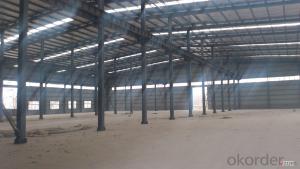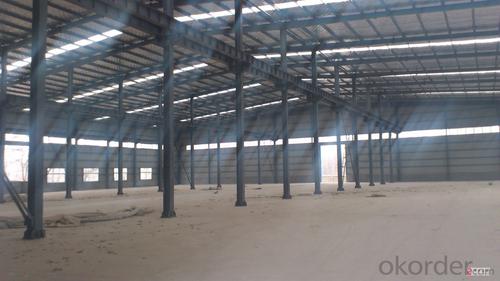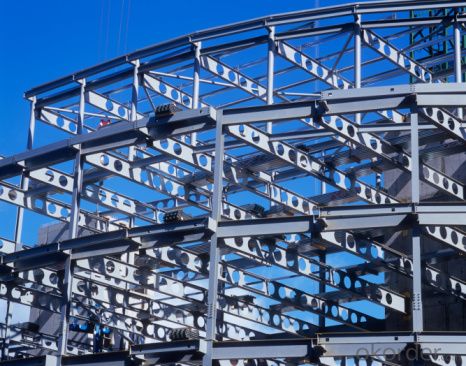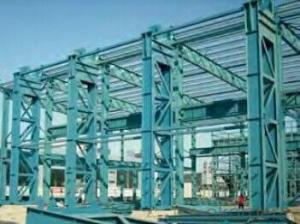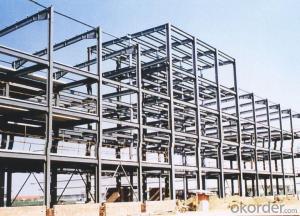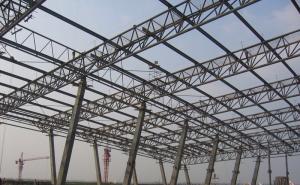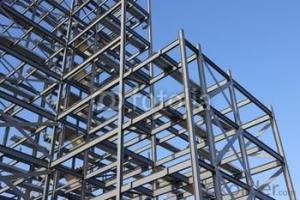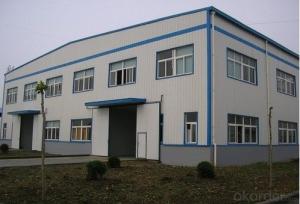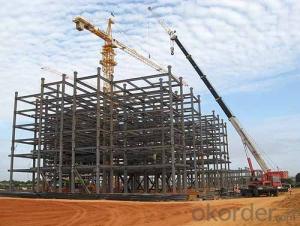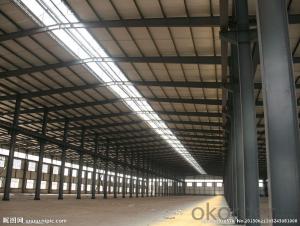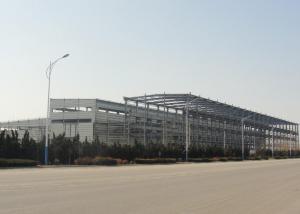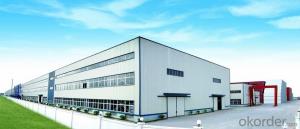Steel Structure Workshop and Steel Structure Warehouse
- Loading Port:
- China Main Port
- Payment Terms:
- TT or LC
- Min Order Qty:
- -
- Supply Capability:
- -
OKorder Service Pledge
OKorder Financial Service
You Might Also Like
Product Description:
OKorder is offering steel structure at great prices with worldwide shipping. Our supplier is a world-class manufacturer of steel, with our products utilized the world over. OKorder annually supplies products to European, North American and Asian markets. We provide quotations within 24 hours of receiving an inquiry and guarantee competitive prices.
Product Applications:
1. Heavy industrial plants: relatively large span and column spacing; with a heavy duty crane or large-tonnage cranes; or plants with 2 to 3 layers cranes; as well as some high-temperature workshop should adopt steel crane beams, steel components, steel roof, steel columns, etc. up to the whole structure
2. Large span structure: the greater the span of the structure, the more significant economic benefits will have by reducing the weight of the structure
3. Towering structures and high-rise buildings: the towering structure, including high-voltage transmission line towers, substation structure, radio and television emission towers and masts, etc. These structures are mainly exposed to the wind load. Besides of its light weight and easy installation, structure steel can bring upon with more economic returns by reducing the wind load through its high-strength and smaller member section.
4. Structure under dynamic loads: As steel with good dynamic performance and toughness, so it can be used directly to crane beam bearing a greater or larger span bridge crane
5. Removable and mobile structures: Structure Steel can also apply to movable Exhibition hall and prefabricated house etc by virtue of its light weight, bolt connection, easy installation and uninstallation. In case of construction machinery, it is a must to use structure steel so as to reduce the structural weight.
6. Containers and pipes: the high-pressure pipe and pipeline, gas tank and boiler are all made of steel for the sake of its high strength and leakproofness
7. Light steel structure: light steel structures and portal frame structure combined with single angle or thin-walled structural steel with the advantages of light weight, build fast and steel saving etc., in recent years has been widely used.
8. Other buildings: Transport Corridor, trestle and various pipeline support frame, as well as blast furnaces and boilers frameworks are usually made of steel structure.
All in all, according to the reality, structure steel is widely used for high, large, heavy and light construction.
Product Advantages:
OKorder's steel structure are durable, strong, and resist corrosion.
Main Product Features:
· Premium quality
· Prompt delivery & seaworthy packing (30 days after receiving deposit)
· Corrosion resistance
· Can be recycled and reused
· Mill test certification
· Professional Service
· Competitive pricing
Product Specifications:
Specifications of steel structure
Project: Jinan west railway station
Position: The Beijing-Shanghai high speed railway (Jinan)
Steel dosage: 5000MTs
Structure type: Box, tube, bending and twisting, transverse connection
1. GB standard material
2. High Structural safety and reliability
3. The production can reach GB/JIS/ISO/ASME standard
Packaging & Delivery of steel structure
1. According to the project design and the component size, usually the main component parts are nude packing and shipped by bulk vessel. And the small parts are packed in box or suitable packages and shipped by containers.
2. This will be communicated and negotiated with buyer according to the design.
Technical support of steel structure
Worker | Rate of frontline workers with certificate on duty reaches 100% |
Welder | 186 welders got AWS & ASME qualification 124 welders got JIS qualification 56 welders got DNV &BV qualification |
Technical inspector | 40 inspectors with UT 2 certificate 10 inspectors with RT 2 certificate 12 inspectors with MT 2 certificate 3 inspectors with UT3 certificate |
Engineer | 21 engineers with senior title 49 engineers with medium title 70 engineers with primary title. 61 First-Class Construction Engineers 182 Second-Class Construction Engineers |
International certification | 10 engineers with International Welding engineer, 8 engineers with CWI. |
Production Flow of steel structure/steel frame
Material preparation—cutting—fitting up—welding—component correction—rust removal—paint coating—packing—to storage and transportation (each process has the relevant inspection)
FAQ:
Q1: Why buy Materials & Equipment from OKorder.com?
A1: All products offered byOKorder.com are carefully selected from China's most reliable manufacturing enterprises. Through its ISO certifications, OKorder.com adheres to the highest standards and a commitment to supply chain safety and customer satisfaction.
Q2: How do we guarantee the quality of our products?
A2: We have established an advanced quality management system which conducts strict quality tests at every step, from raw materials to the final product. At the same time, we provide extensive follow-up service assurances as required.
Q3: How soon can we receive the product after purchase?
A3: Within three days of placing an order, we will begin production. The specific shipping date is dependent upon international and government factors, but is typically 7 to 10 workdays.
Q4: What makes stainless steel stainless?
A4: Stainless steel must contain at least 10.5 % chromium. It is this element that reacts with the oxygen in the air to form a complex chrome-oxide surface layer that is invisible but strong enough to prevent further oxygen from "staining" (rusting) the surface. Higher levels of chromium and the addition of other alloying elements such as nickel and molybdenum enhance this surface layer and improve the corrosion resistance of the stainless material.
Q5: Can stainless steel rust?
A5: Stainless does not "rust" as you think of regular steel rusting with a red oxide on the surface that flakes off. If you see red rust it is probably due to some iron particles that have contaminated the surface of the stainless steel and it is these iron particles that are rusting. Look at the source of the rusting and see if you can remove it from the surface.
Images:
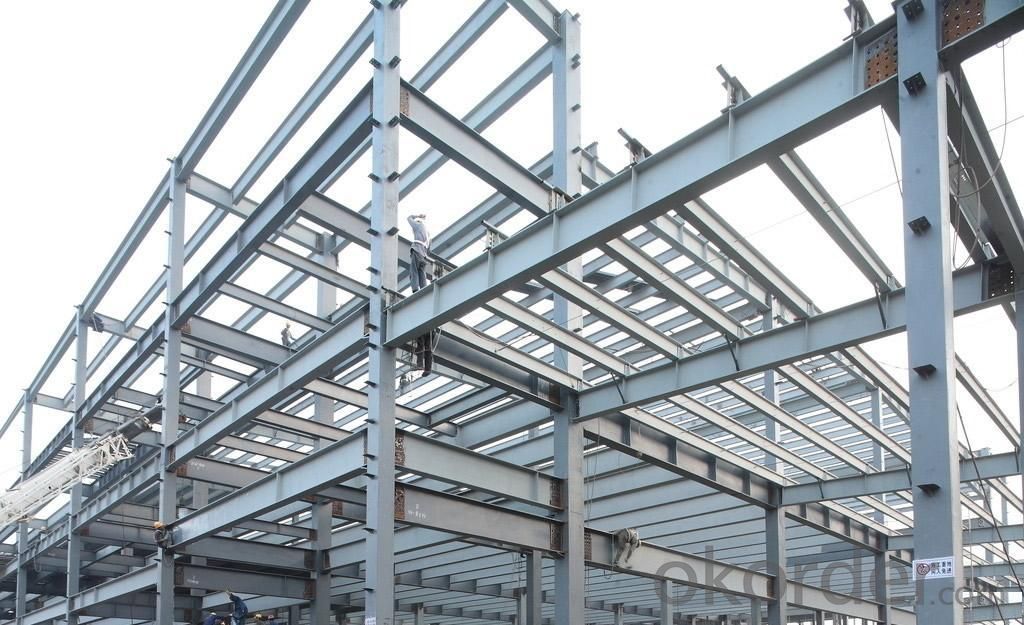
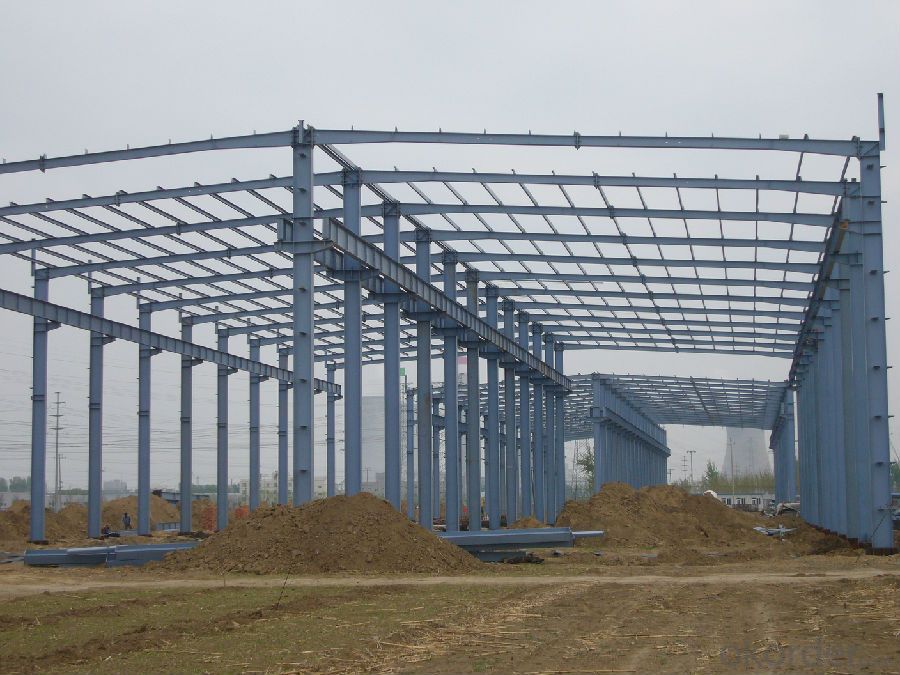
- Q: What is the role of steel in hotels and hospitality buildings?
- Due to its numerous advantages and properties, steel plays a crucial role in hotels and hospitality buildings. The strength and durability of steel make it an ideal choice for constructing large, multi-story structures like hotels. It can withstand heavy loads and resist external forces, ensuring the safety and structural integrity of the building. The versatility of steel allows for flexible and efficient design options, enabling architects and engineers to create unique and visually appealing hotel structures. Its high strength-to-weight ratio allows for spacious areas without the need for interior columns, enhancing the overall functionality of the building. This flexibility also allows for future modifications and expansions to meet changing market demands. In addition to its structural benefits, steel is fire-resistant, providing an added layer of safety in hospitality buildings. It does not burn, warp, or emit toxic fumes when exposed to fire, reducing the risk of damage and ensuring the safety of guests and staff. Steel's durability translates to reduced maintenance costs for hotels. It is resistant to corrosion and deterioration, resulting in a longer lifespan compared to other materials. This reduces the need for frequent repairs and replacements, saving hotels money in the long run. Furthermore, steel construction is known for its speed and efficiency. Off-site fabrication and on-site assembly allow for faster construction schedules, minimizing disruption to hotel operations and enabling them to generate revenue sooner. Lastly, steel's sustainability and eco-friendliness make it a desirable choice for hospitality buildings. It is recyclable and can be repurposed at the end of its lifespan, reducing the environmental impact. Additionally, the use of steel in construction requires fewer materials and produces less waste compared to traditional building methods, reducing the overall carbon footprint. In conclusion, steel's role in hotels and hospitality buildings encompasses strength, durability, versatility, fire-resistance, low maintenance requirements, speed of construction, and sustainability. These qualities make steel an essential component in creating safe, efficient, and visually appealing structures that can meet the needs of the ever-evolving hospitality industry.
- Q: What are the key considerations in the design of steel structures for entertainment venues?
- When it comes to designing steel structures for entertainment venues, there are several crucial factors that must be taken into consideration. These factors include: 1. Load Capacity: Ensuring that the steel structure can safely and efficiently support the weight of large crowds, heavy equipment, and stage setups is of utmost importance. 2. Flexibility and Adaptability: Entertainment venues are constantly changing spaces, requiring frequent modifications and adjustments. The design should allow for easy and seamless alterations without compromising the structural integrity of the building. 3. Acoustics: Achieving optimal sound quality is essential in entertainment venues. The steel structure should be designed in a way that minimizes sound transmission and reverberation, creating the perfect acoustics for performances and events. 4. Safety and Fire Protection: Safety is a top priority in any building, especially in entertainment venues where large crowds gather. The steel structure should be designed to meet fire safety codes, providing adequate emergency exits and easy access for firefighters. 5. Aesthetics: Entertainment venues often serve as architectural landmarks and must have an appealing design. The steel structure should be aesthetically pleasing, complementing the overall theme and design of the venue. 6. Durability and Maintenance: Steel structures should be designed to withstand the test of time, resisting corrosion and deterioration. Additionally, proper maintenance procedures should be considered to ensure the longevity of the structure. 7. Sustainability: In today's environmentally conscious world, designing sustainable structures is becoming increasingly important. When designing steel structures for entertainment venues, it is crucial to consider the use of recycled materials, energy-efficient design strategies, and environmentally friendly construction practices. By taking these key factors into account, architects and engineers can create steel structures that not only provide a safe and functional space for entertainment but also enhance the overall experience for performers and audiences.
- Q: How are steel structures designed to be resistant to corrosion?
- Steel structures are designed to be resistant to corrosion through a combination of material selection, coating application, and maintenance. Firstly, the choice of the right steel grade is crucial. Stainless steel, for example, contains a higher percentage of chromium which forms a protective oxide layer on the surface, preventing corrosion. Additionally, galvanized steel is often used, where a layer of zinc is applied to the steel surface to act as a sacrificial barrier against corrosion. Furthermore, proper coating application plays a vital role in protecting steel structures. Epoxy and polyurethane coatings are commonly used to create a physical barrier between the steel and the environment, preventing moisture and corrosive substances from reaching the surface. These coatings are applied in multiple layers to ensure maximum protection. Regular maintenance is also essential in ensuring the corrosion resistance of steel structures. This includes inspecting for any signs of damage or coating deterioration, and promptly addressing them. Regular cleaning, removing any accumulated dirt or debris, can also prevent corrosion by reducing the potential for moisture retention. In summary, steel structures are designed to be resistant to corrosion through the use of appropriate steel grades, protective coatings, and regular maintenance. These measures collectively help to extend the lifespan of steel structures and maintain their structural integrity.
- Q: What is the role of steel in historical and heritage buildings?
- The role of steel in historical and heritage buildings is significant and multifaceted. Steel has played a crucial role in the construction and preservation of these structures, providing strength, durability, and versatility. Historically, steel became a prominent material in the late 19th and early 20th centuries with the advent of the Industrial Revolution. Its introduction revolutionized the architecture and engineering industries, allowing for the construction of taller and more expansive buildings. The use of steel frames and beams provided a higher level of structural support, enabling architects to create grand structures with larger open spaces and intricate designs. In heritage buildings, steel has often been utilized during restoration and rehabilitation projects. Many historical buildings suffer from structural deterioration over time, and steel is often used to reinforce weakened or damaged sections. Its high tensile strength and ability to withstand heavy loads make it an ideal material for reinforcing weakened foundations, walls, or floors. Moreover, steel is also used in the restoration of ornate architectural elements. Historical buildings often feature intricate ironwork, such as balconies, railings, or decorative facades. When these elements become rusted or damaged, steel can be used to replicate or replace them, ensuring the preservation of the building's original aesthetic. Additionally, steel plays a crucial role in the adaptive reuse of historical and heritage buildings. Many old structures are repurposed for new functions, such as converting a factory into a museum or a warehouse into residential lofts. Steel's versatility allows architects and engineers to modify the building's interior layout while retaining its historical exterior. Steel beams can be added or modified to accommodate new spaces or support additional floors, providing the necessary flexibility for modern usage. Lastly, steel is a sustainable choice for historical and heritage buildings. Its recyclability and durability make it an environmentally friendly material. By using steel in restoration or adaptive reuse projects, we can reduce the need for new materials and minimize waste, contributing to the preservation of these invaluable structures for future generations. In conclusion, steel plays a vital role in historical and heritage buildings, both in their initial construction and ongoing preservation. Its strength, durability, versatility, and sustainability make it the material of choice for reinforcing structures, restoring ornate elements, adapting buildings for new uses, and ensuring the longevity of these iconic landmarks.
- Q: Steel structure component assembling method
- A method of assembling a part of a component with a die in its assembly position. This assembly method is suitable for large volume and high precision products.
- Q: How are steel structures designed for thermal bridging prevention?
- Steel structures are designed for thermal bridging prevention through the use of thermal breaks and insulation. Thermal breaks are insulating materials placed between the steel elements to interrupt the path of heat transfer. Insulation is also added to minimize heat transfer through the steel structure. These design measures help to reduce thermal bridging, ensuring better energy efficiency and thermal performance of the steel structure.
- Q: How are steel structures used in military and defense facilities?
- Steel structures are extensively used in military and defense facilities due to their unique properties that make them ideal for the demanding requirements of such establishments. One key application is the construction of military hangars and aircraft maintenance facilities. These structures provide a secure and controlled environment for the storage and maintenance of military aircraft, offering protection against harsh weather conditions and potential threats. Moreover, steel structures are used in the construction of command centers, barracks, and other administrative buildings. These buildings require a robust and durable framework to withstand potential attacks and provide a safe working environment for military personnel. Steel is also utilized in the construction of ammunition storage facilities and armories. Its strength and fire resistance properties ensure the safety and security of stored munitions, minimizing the risk of accidents or unauthorized access. In addition, steel structures play a crucial role in the construction of military training facilities. These facilities often require large open spaces, which can be efficiently achieved using steel structures. Steel allows for large spans and column-free spaces, providing flexibility for various training activities such as obstacle courses, shooting ranges, and combat simulations. Another significant application of steel structures in military and defense facilities is in the construction of border checkpoints and security infrastructure. Steel barriers, fences, and gates are used to fortify perimeters and control access points, enhancing security and preventing unauthorized entry. Overall, the use of steel structures in military and defense facilities ensures the strength, durability, and security necessary to protect personnel, equipment, and strategic assets. The versatility and structural integrity of steel make it an essential material in the construction of these vital facilities.
- Q: Can steel structures be designed for easy dismantling and reuse?
- Yes, steel structures can be designed for easy dismantling and reuse. Steel is a highly recyclable material, and its inherent strength and flexibility allow for efficient disassembly and reassembly without compromising its structural integrity. By using modular components and connections that can be easily detached, steel structures can be dismantled and reused in various applications, reducing waste and promoting sustainability in the construction industry.
- Q: Can steel structures be customized or modified easily?
- Yes, steel structures can be easily customized or modified. Steel is a versatile material that allows for easy modifications, such as adding or removing sections, altering the shape or size, or even relocating the structure. It offers flexibility in design and construction, making it a preferred choice for customizable structures.
- Q: How does steel perform in extreme weather conditions, such as earthquakes or hurricanes?
- Steel is renowned for its exceptional strength and durability, making it a favored option for construction in severe weather conditions. During earthquakes, steel exhibits outstanding performance due to its high tensile strength and ductility. These characteristics allow steel structures to effectively absorb and distribute the energy generated during an earthquake, thus minimizing the impact on the overall structure. Steel buildings are specifically designed to flex and bend without fracturing, enabling them to withstand the lateral forces caused by seismic activity. Similarly, steel possesses remarkable resistance against hurricane forces. Its strength and rigidity empower it to endure strong winds and airborne debris that typically accompany hurricanes. Steel structures can be engineered to have a greater resistance to wind loads by incorporating additional bracing and connections. Consequently, steel buildings are less prone to damage and collapse during extreme weather events. Moreover, the resistance of steel to corrosion is advantageous in regions susceptible to hurricanes or earthquakes. The application of protective coatings to steel structures prevents rust and deterioration, ensuring the material remains robust and reliable in harsh weather conditions. However, it is vital to acknowledge that the performance of steel in extreme weather conditions is also contingent upon the design and construction techniques employed. Proper engineering practices, including the utilization of appropriate connections and reinforcements, play a critical role in maximizing the resilience of steel structures. Additionally, adherence to building codes and regulations specific to seismic or hurricane-prone areas is essential to guarantee the safety and performance of steel buildings in these severe weather conditions.
Send your message to us
Steel Structure Workshop and Steel Structure Warehouse
- Loading Port:
- China Main Port
- Payment Terms:
- TT or LC
- Min Order Qty:
- -
- Supply Capability:
- -
OKorder Service Pledge
OKorder Financial Service
Similar products
Hot products
Hot Searches
Related keywords
